Comprehensive Financial Statement Analysis of Tesco (2018-2020)
VerifiedAdded on 2023/06/14
|18
|2881
|474
Report
AI Summary
This report provides a comprehensive financial statement analysis of Tesco PLC from 2018 to 2020, focusing on key financial ratios to assess the company's performance. The analysis includes liquidity ratios (current, quick, and cash ratios), profitability ratios (gross margin, operating margin, pretax margin, net profit margin, return on equity, and return on assets), leverage ratios (debt/equity ratio, debt/capital ratio, and equity multiplier), and working capital ratios (accounts receivable days). The report interprets these ratios, highlighting trends and potential issues, such as lower debt capital and cash ratios. Recommendations are provided to improve financial control systems and operational activities. The overall analysis suggests a positive picture of Tesco's performance, with a stable profitability position and a healthy liquidity ratio.

Financial Statement
Analysis for 2018 to
2020 Financial Year
Analysis for 2018 to
2020 Financial Year
Paraphrase This Document
Need a fresh take? Get an instant paraphrase of this document with our AI Paraphraser
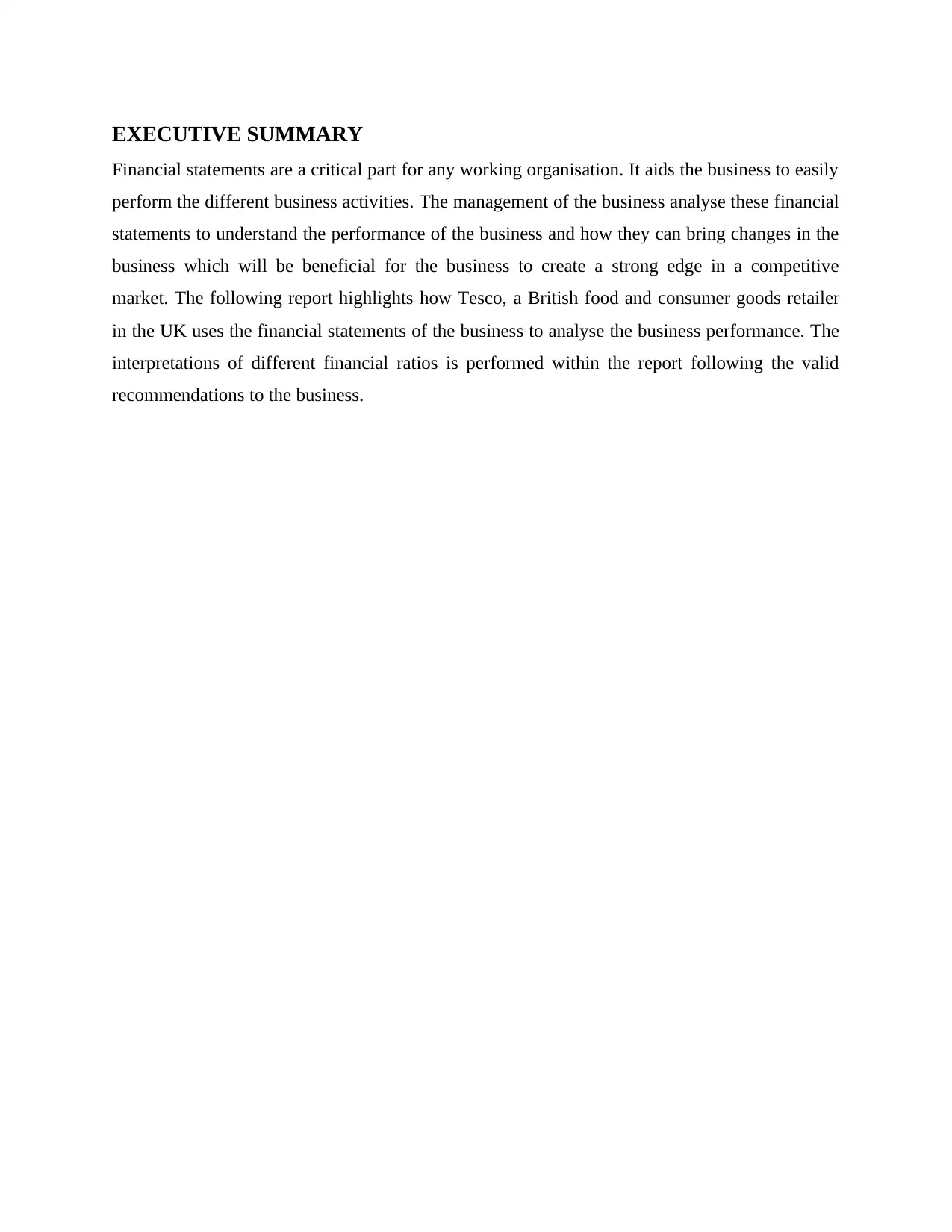
EXECUTIVE SUMMARY
Financial statements are a critical part for any working organisation. It aids the business to easily
perform the different business activities. The management of the business analyse these financial
statements to understand the performance of the business and how they can bring changes in the
business which will be beneficial for the business to create a strong edge in a competitive
market. The following report highlights how Tesco, a British food and consumer goods retailer
in the UK uses the financial statements of the business to analyse the business performance. The
interpretations of different financial ratios is performed within the report following the valid
recommendations to the business.
Financial statements are a critical part for any working organisation. It aids the business to easily
perform the different business activities. The management of the business analyse these financial
statements to understand the performance of the business and how they can bring changes in the
business which will be beneficial for the business to create a strong edge in a competitive
market. The following report highlights how Tesco, a British food and consumer goods retailer
in the UK uses the financial statements of the business to analyse the business performance. The
interpretations of different financial ratios is performed within the report following the valid
recommendations to the business.
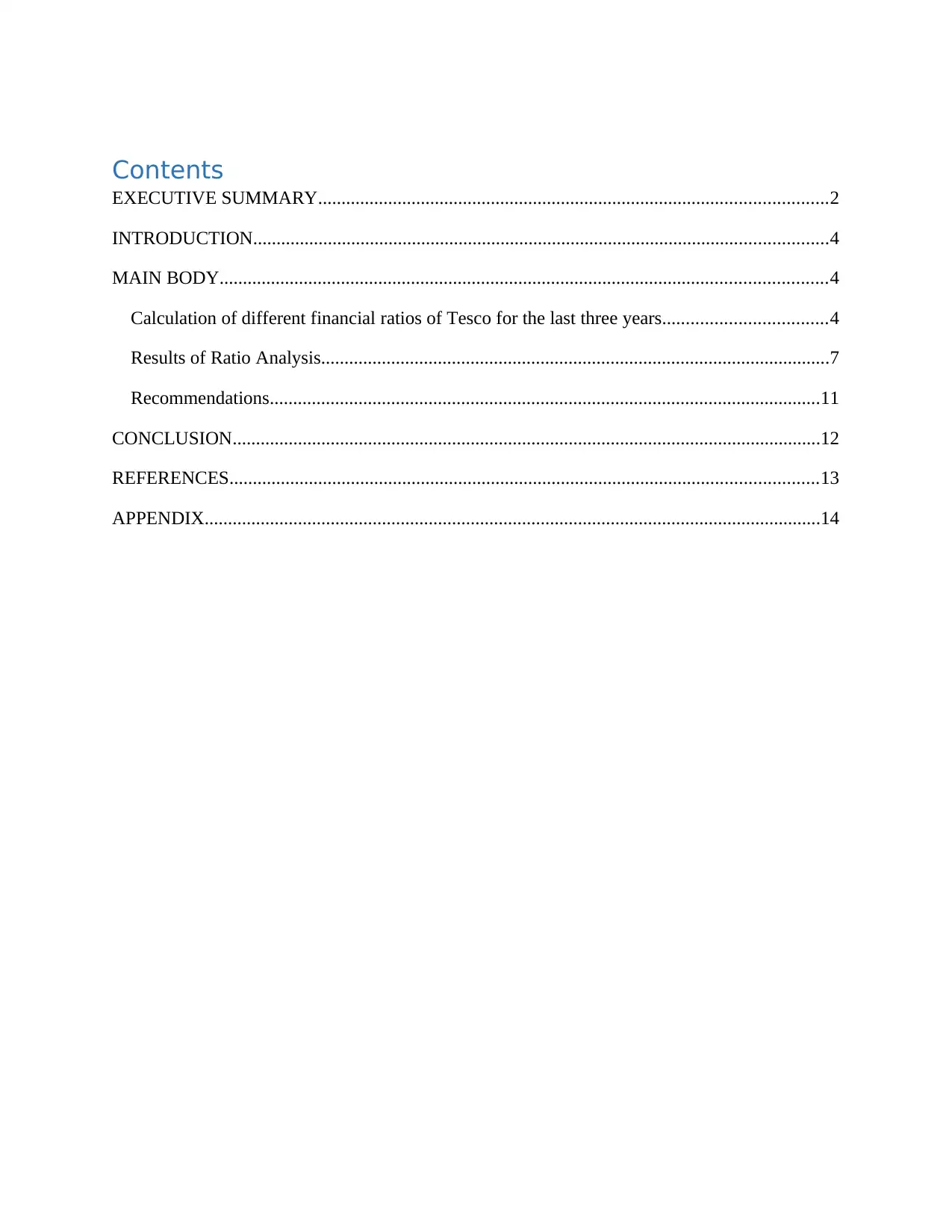
Contents
EXECUTIVE SUMMARY.............................................................................................................2
INTRODUCTION...........................................................................................................................4
MAIN BODY..................................................................................................................................4
Calculation of different financial ratios of Tesco for the last three years...................................4
Results of Ratio Analysis.............................................................................................................7
Recommendations......................................................................................................................11
CONCLUSION..............................................................................................................................12
REFERENCES..............................................................................................................................13
APPENDIX....................................................................................................................................14
EXECUTIVE SUMMARY.............................................................................................................2
INTRODUCTION...........................................................................................................................4
MAIN BODY..................................................................................................................................4
Calculation of different financial ratios of Tesco for the last three years...................................4
Results of Ratio Analysis.............................................................................................................7
Recommendations......................................................................................................................11
CONCLUSION..............................................................................................................................12
REFERENCES..............................................................................................................................13
APPENDIX....................................................................................................................................14
⊘ This is a preview!⊘
Do you want full access?
Subscribe today to unlock all pages.

Trusted by 1+ million students worldwide
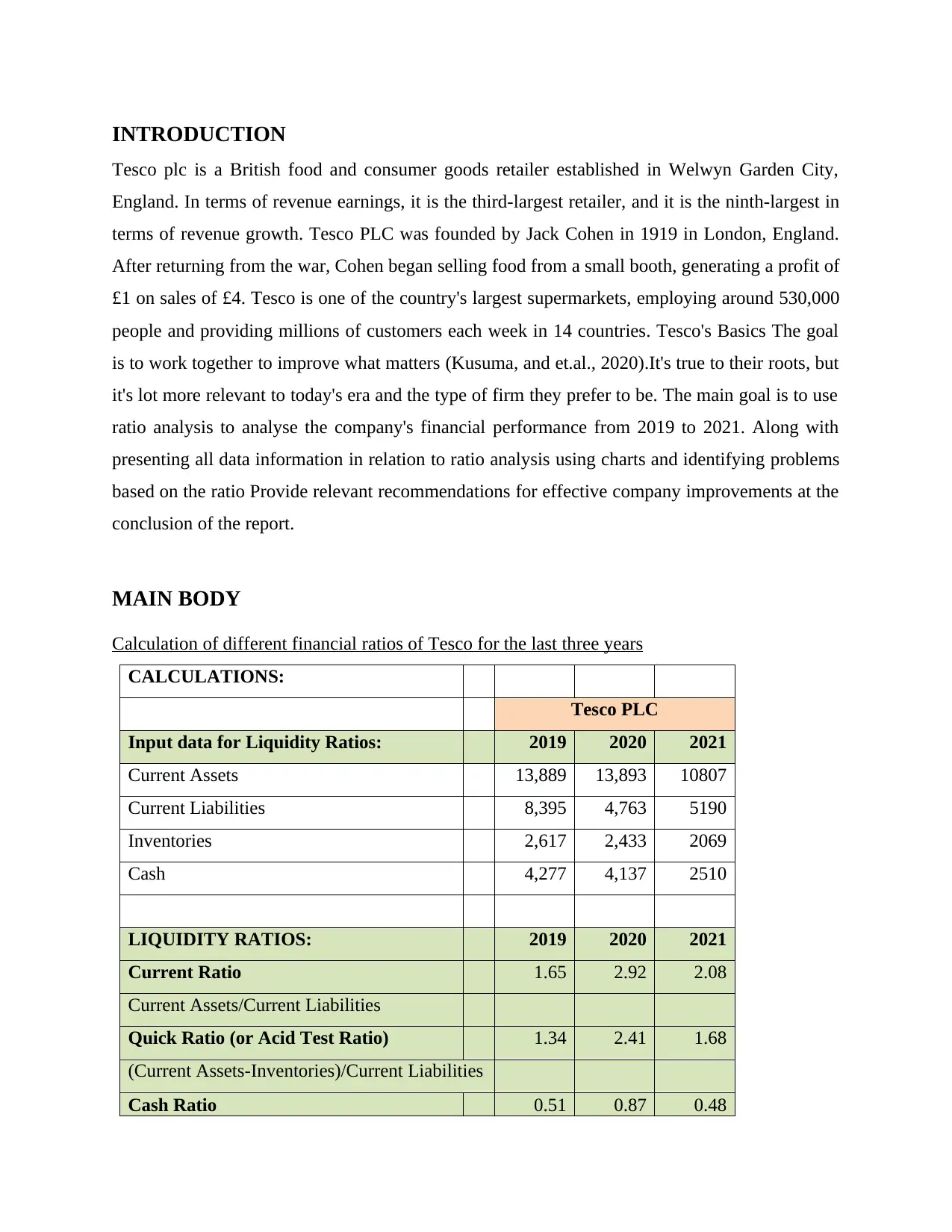
INTRODUCTION
Tesco plc is a British food and consumer goods retailer established in Welwyn Garden City,
England. In terms of revenue earnings, it is the third-largest retailer, and it is the ninth-largest in
terms of revenue growth. Tesco PLC was founded by Jack Cohen in 1919 in London, England.
After returning from the war, Cohen began selling food from a small booth, generating a profit of
£1 on sales of £4. Tesco is one of the country's largest supermarkets, employing around 530,000
people and providing millions of customers each week in 14 countries. Tesco's Basics The goal
is to work together to improve what matters (Kusuma, and et.al., 2020).It's true to their roots, but
it's lot more relevant to today's era and the type of firm they prefer to be. The main goal is to use
ratio analysis to analyse the company's financial performance from 2019 to 2021. Along with
presenting all data information in relation to ratio analysis using charts and identifying problems
based on the ratio Provide relevant recommendations for effective company improvements at the
conclusion of the report.
MAIN BODY
Calculation of different financial ratios of Tesco for the last three years
CALCULATIONS:
Tesco PLC
Input data for Liquidity Ratios: 2019 2020 2021
Current Assets 13,889 13,893 10807
Current Liabilities 8,395 4,763 5190
Inventories 2,617 2,433 2069
Cash 4,277 4,137 2510
LIQUIDITY RATIOS: 2019 2020 2021
Current Ratio 1.65 2.92 2.08
Current Assets/Current Liabilities
Quick Ratio (or Acid Test Ratio) 1.34 2.41 1.68
(Current Assets-Inventories)/Current Liabilities
Cash Ratio 0.51 0.87 0.48
Tesco plc is a British food and consumer goods retailer established in Welwyn Garden City,
England. In terms of revenue earnings, it is the third-largest retailer, and it is the ninth-largest in
terms of revenue growth. Tesco PLC was founded by Jack Cohen in 1919 in London, England.
After returning from the war, Cohen began selling food from a small booth, generating a profit of
£1 on sales of £4. Tesco is one of the country's largest supermarkets, employing around 530,000
people and providing millions of customers each week in 14 countries. Tesco's Basics The goal
is to work together to improve what matters (Kusuma, and et.al., 2020).It's true to their roots, but
it's lot more relevant to today's era and the type of firm they prefer to be. The main goal is to use
ratio analysis to analyse the company's financial performance from 2019 to 2021. Along with
presenting all data information in relation to ratio analysis using charts and identifying problems
based on the ratio Provide relevant recommendations for effective company improvements at the
conclusion of the report.
MAIN BODY
Calculation of different financial ratios of Tesco for the last three years
CALCULATIONS:
Tesco PLC
Input data for Liquidity Ratios: 2019 2020 2021
Current Assets 13,889 13,893 10807
Current Liabilities 8,395 4,763 5190
Inventories 2,617 2,433 2069
Cash 4,277 4,137 2510
LIQUIDITY RATIOS: 2019 2020 2021
Current Ratio 1.65 2.92 2.08
Current Assets/Current Liabilities
Quick Ratio (or Acid Test Ratio) 1.34 2.41 1.68
(Current Assets-Inventories)/Current Liabilities
Cash Ratio 0.51 0.87 0.48
Paraphrase This Document
Need a fresh take? Get an instant paraphrase of this document with our AI Paraphraser

Cash/Current Liabilities
Tesco PLC
Input data for Profitability Ratios: 2019 2020 2021
Gross Profit 4,696 4,098 3965
Operating Income 2,649 2,206 1736
Pre Tax Income 1,617 1,028 825
Net Income 1,270 973 6147
Sales 63,911 58,091 57887
Total Equity 13,548 13,369 12325
Total Assets 58,325 53,147 45,778
PROFITABILITY RATIOS: 2019 2020 2021
Gross Margin 0.07 0.07 0.07
Gross Profit/Sales
Operating Margin 0.04 0.04 0.03
Operating Income/Sales
PreTax Margin 0.03 0.02 0.01
PreTax Income/Sales
Net Profit Margin 0.02 0.02 0.11
Net Income/Sales
Return on Equity (ROE) 0.09 0.07 0.50
Net Income/Tot.Equity
Return on Assets (ROA) 0.02 0.02 0.13
Net Income/Tot.Assets
LEVERAGE RATIOS Input: 2019 2020 2021
Total Debt 44,777 39,778 33,453
Total Equity 13,548 13,369 12325
Tesco PLC
Input data for Profitability Ratios: 2019 2020 2021
Gross Profit 4,696 4,098 3965
Operating Income 2,649 2,206 1736
Pre Tax Income 1,617 1,028 825
Net Income 1,270 973 6147
Sales 63,911 58,091 57887
Total Equity 13,548 13,369 12325
Total Assets 58,325 53,147 45,778
PROFITABILITY RATIOS: 2019 2020 2021
Gross Margin 0.07 0.07 0.07
Gross Profit/Sales
Operating Margin 0.04 0.04 0.03
Operating Income/Sales
PreTax Margin 0.03 0.02 0.01
PreTax Income/Sales
Net Profit Margin 0.02 0.02 0.11
Net Income/Sales
Return on Equity (ROE) 0.09 0.07 0.50
Net Income/Tot.Equity
Return on Assets (ROA) 0.02 0.02 0.13
Net Income/Tot.Assets
LEVERAGE RATIOS Input: 2019 2020 2021
Total Debt 44,777 39,778 33,453
Total Equity 13,548 13,369 12325
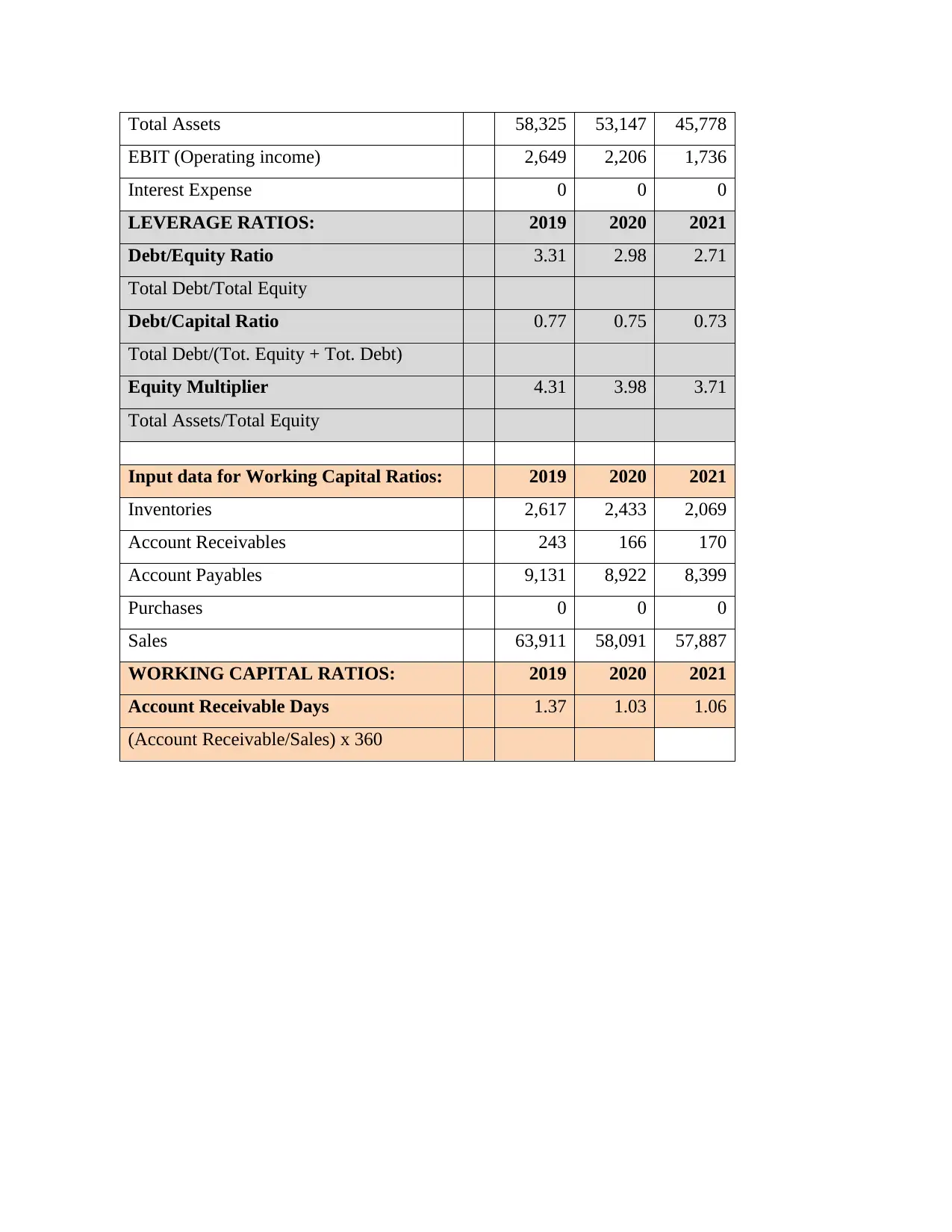
Total Assets 58,325 53,147 45,778
EBIT (Operating income) 2,649 2,206 1,736
Interest Expense 0 0 0
LEVERAGE RATIOS: 2019 2020 2021
Debt/Equity Ratio 3.31 2.98 2.71
Total Debt/Total Equity
Debt/Capital Ratio 0.77 0.75 0.73
Total Debt/(Tot. Equity + Tot. Debt)
Equity Multiplier 4.31 3.98 3.71
Total Assets/Total Equity
Input data for Working Capital Ratios: 2019 2020 2021
Inventories 2,617 2,433 2,069
Account Receivables 243 166 170
Account Payables 9,131 8,922 8,399
Purchases 0 0 0
Sales 63,911 58,091 57,887
WORKING CAPITAL RATIOS: 2019 2020 2021
Account Receivable Days 1.37 1.03 1.06
(Account Receivable/Sales) x 360
EBIT (Operating income) 2,649 2,206 1,736
Interest Expense 0 0 0
LEVERAGE RATIOS: 2019 2020 2021
Debt/Equity Ratio 3.31 2.98 2.71
Total Debt/Total Equity
Debt/Capital Ratio 0.77 0.75 0.73
Total Debt/(Tot. Equity + Tot. Debt)
Equity Multiplier 4.31 3.98 3.71
Total Assets/Total Equity
Input data for Working Capital Ratios: 2019 2020 2021
Inventories 2,617 2,433 2,069
Account Receivables 243 166 170
Account Payables 9,131 8,922 8,399
Purchases 0 0 0
Sales 63,911 58,091 57,887
WORKING CAPITAL RATIOS: 2019 2020 2021
Account Receivable Days 1.37 1.03 1.06
(Account Receivable/Sales) x 360
⊘ This is a preview!⊘
Do you want full access?
Subscribe today to unlock all pages.

Trusted by 1+ million students worldwide

Results of Ratio Analysis
2019 2020 2021
0
0.5
1
1.5
2
2.5
3
1.65
2.92
2.08
1.34
2.41
1.68
0.51
0.87
0.48
Current Ratio
Quick Ratio (or Acid Test
Ratio)
Cash Ratio
Interpretation of Liquidity Ratios: The column chart is used to properly analyse Tesco plc's
liquidity position and present a specific situation. Tesco plc's current ratio was 0.65 in 2019,
rising to 2.92 in 2020 and 2.08 in 2021. Present the Tesco goof optimum ratio in three years,
2021. The current ratio assesses a company's ability to generate revenue in order to meet its
short-term obligations (Rahman, and et.al., 2020) . This ratio could fall due to a rise in short-term
debt, a drop in current assets, or a combination of the two.
The ability to repay short-term loans in a short period of time is represented by the quick
ratio. In 2019, Tesco's quick ratio was 1.34, 2.41 in 2020, and 1.68 in 2021. Current assets are
predominantly reliant on inventories if the quick ratio is much lower than the standard ratio. A
quick ratio larger than one indicates that a company has more short-term assets than current
liabilities. When the quick ratio rises, the cheaper option improves.
Tesco's cash ratio was 0.51 in 2019, climbing to 0.87 in 2020 and 0.48 in 2021 before
declining. A higher cash coverage ratio, like other liquidity ratios, suggests that the company is
more adaptable and can fulfil its obligations more quickly. Borrowers care about this percentage
because they want to know that their debts will be paid back. Any ratio larger than one is
considered a good sign of liquidity. A cash ratio of less than one may indicate that a company is
in financial trouble. A low cash ratio, on the other hand, could indicate a company's unique
2019 2020 2021
0
0.5
1
1.5
2
2.5
3
1.65
2.92
2.08
1.34
2.41
1.68
0.51
0.87
0.48
Current Ratio
Quick Ratio (or Acid Test
Ratio)
Cash Ratio
Interpretation of Liquidity Ratios: The column chart is used to properly analyse Tesco plc's
liquidity position and present a specific situation. Tesco plc's current ratio was 0.65 in 2019,
rising to 2.92 in 2020 and 2.08 in 2021. Present the Tesco goof optimum ratio in three years,
2021. The current ratio assesses a company's ability to generate revenue in order to meet its
short-term obligations (Rahman, and et.al., 2020) . This ratio could fall due to a rise in short-term
debt, a drop in current assets, or a combination of the two.
The ability to repay short-term loans in a short period of time is represented by the quick
ratio. In 2019, Tesco's quick ratio was 1.34, 2.41 in 2020, and 1.68 in 2021. Current assets are
predominantly reliant on inventories if the quick ratio is much lower than the standard ratio. A
quick ratio larger than one indicates that a company has more short-term assets than current
liabilities. When the quick ratio rises, the cheaper option improves.
Tesco's cash ratio was 0.51 in 2019, climbing to 0.87 in 2020 and 0.48 in 2021 before
declining. A higher cash coverage ratio, like other liquidity ratios, suggests that the company is
more adaptable and can fulfil its obligations more quickly. Borrowers care about this percentage
because they want to know that their debts will be paid back. Any ratio larger than one is
considered a good sign of liquidity. A cash ratio of less than one may indicate that a company is
in financial trouble. A low cash ratio, on the other hand, could indicate a company's unique
Paraphrase This Document
Need a fresh take? Get an instant paraphrase of this document with our AI Paraphraser
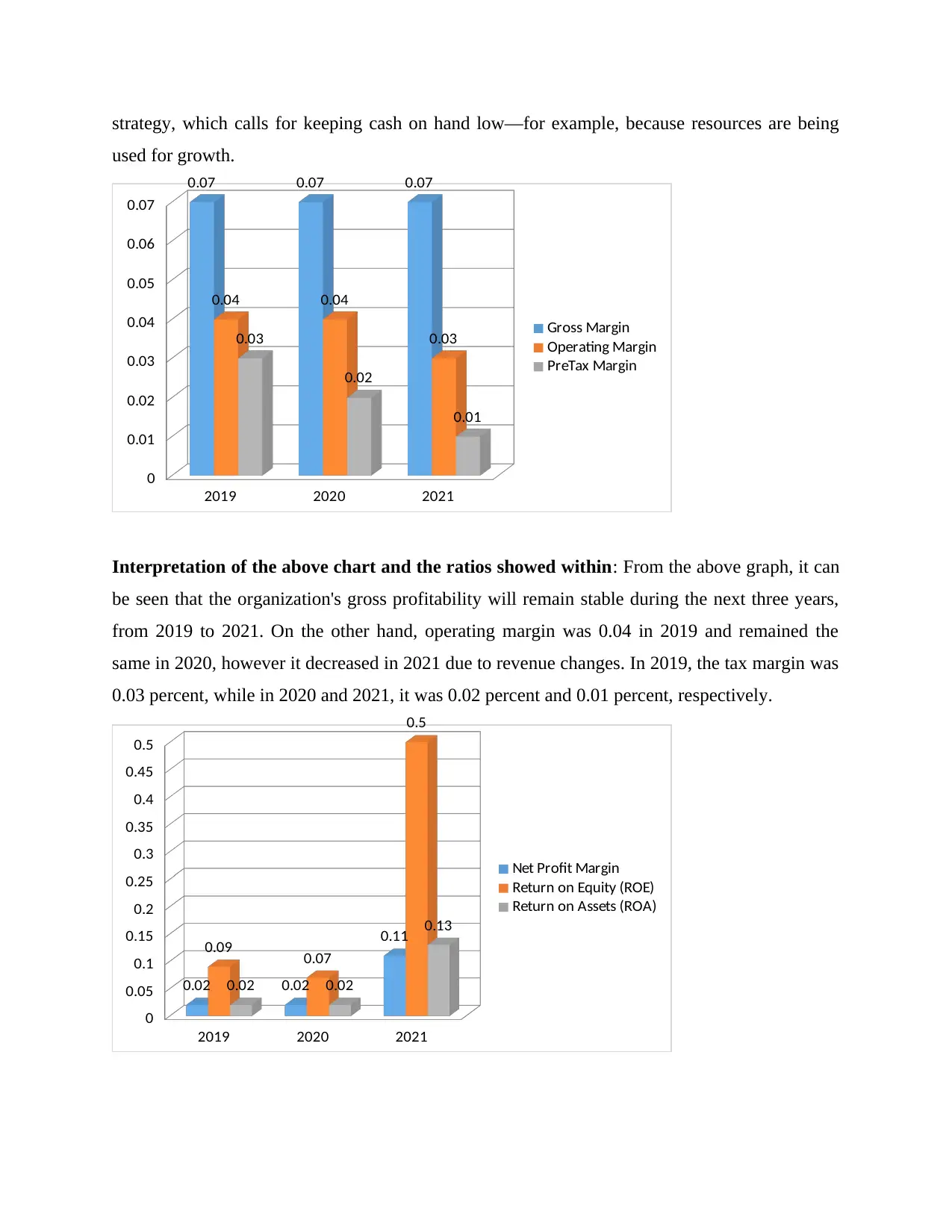
strategy, which calls for keeping cash on hand low—for example, because resources are being
used for growth.
2019 2020 2021
0
0.01
0.02
0.03
0.04
0.05
0.06
0.07
0.07 0.07 0.07
0.04 0.04
0.030.03
0.02
0.01
Gross Margin
Operating Margin
PreTax Margin
Interpretation of the above chart and the ratios showed within: From the above graph, it can
be seen that the organization's gross profitability will remain stable during the next three years,
from 2019 to 2021. On the other hand, operating margin was 0.04 in 2019 and remained the
same in 2020, however it decreased in 2021 due to revenue changes. In 2019, the tax margin was
0.03 percent, while in 2020 and 2021, it was 0.02 percent and 0.01 percent, respectively.
2019 2020 2021
0
0.05
0.1
0.15
0.2
0.25
0.3
0.35
0.4
0.45
0.5
0.02 0.02
0.11
0.09 0.07
0.5
0.02 0.02
0.13
Net Profit Margin
Return on Equity (ROE)
Return on Assets (ROA)
used for growth.
2019 2020 2021
0
0.01
0.02
0.03
0.04
0.05
0.06
0.07
0.07 0.07 0.07
0.04 0.04
0.030.03
0.02
0.01
Gross Margin
Operating Margin
PreTax Margin
Interpretation of the above chart and the ratios showed within: From the above graph, it can
be seen that the organization's gross profitability will remain stable during the next three years,
from 2019 to 2021. On the other hand, operating margin was 0.04 in 2019 and remained the
same in 2020, however it decreased in 2021 due to revenue changes. In 2019, the tax margin was
0.03 percent, while in 2020 and 2021, it was 0.02 percent and 0.01 percent, respectively.
2019 2020 2021
0
0.05
0.1
0.15
0.2
0.25
0.3
0.35
0.4
0.45
0.5
0.02 0.02
0.11
0.09 0.07
0.5
0.02 0.02
0.13
Net Profit Margin
Return on Equity (ROE)
Return on Assets (ROA)
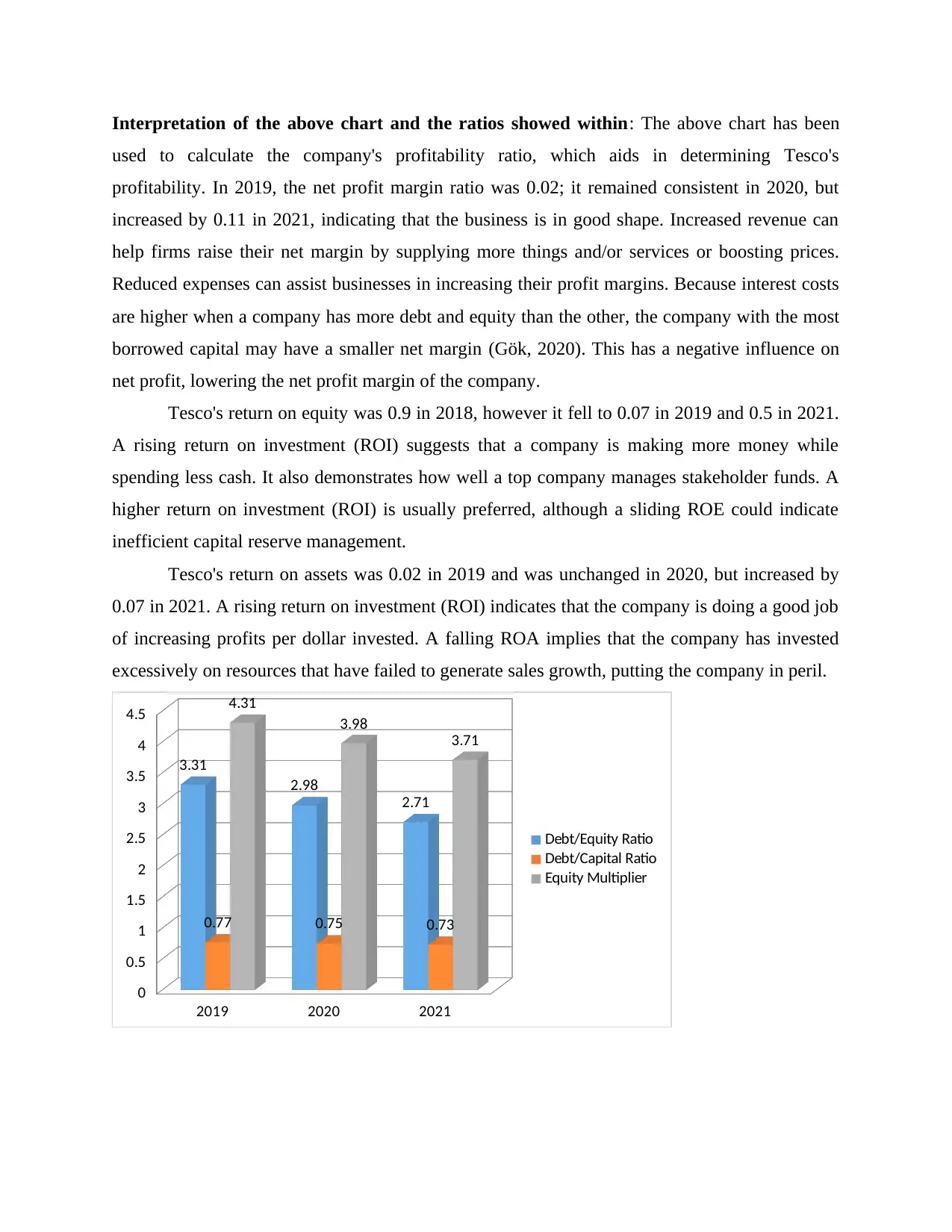
Interpretation of the above chart and the ratios showed within: The above chart has been
used to calculate the company's profitability ratio, which aids in determining Tesco's
profitability. In 2019, the net profit margin ratio was 0.02; it remained consistent in 2020, but
increased by 0.11 in 2021, indicating that the business is in good shape. Increased revenue can
help firms raise their net margin by supplying more things and/or services or boosting prices.
Reduced expenses can assist businesses in increasing their profit margins. Because interest costs
are higher when a company has more debt and equity than the other, the company with the most
borrowed capital may have a smaller net margin (Gök, 2020). This has a negative influence on
net profit, lowering the net profit margin of the company.
Tesco's return on equity was 0.9 in 2018, however it fell to 0.07 in 2019 and 0.5 in 2021.
A rising return on investment (ROI) suggests that a company is making more money while
spending less cash. It also demonstrates how well a top company manages stakeholder funds. A
higher return on investment (ROI) is usually preferred, although a sliding ROE could indicate
inefficient capital reserve management.
Tesco's return on assets was 0.02 in 2019 and was unchanged in 2020, but increased by
0.07 in 2021. A rising return on investment (ROI) indicates that the company is doing a good job
of increasing profits per dollar invested. A falling ROA implies that the company has invested
excessively on resources that have failed to generate sales growth, putting the company in peril.
2019 2020 2021
0
0.5
1
1.5
2
2.5
3
3.5
4
4.5
3.31
2.98
2.71
0.77 0.75 0.73
4.31
3.98
3.71
Debt/Equity Ratio
Debt/Capital Ratio
Equity Multiplier
used to calculate the company's profitability ratio, which aids in determining Tesco's
profitability. In 2019, the net profit margin ratio was 0.02; it remained consistent in 2020, but
increased by 0.11 in 2021, indicating that the business is in good shape. Increased revenue can
help firms raise their net margin by supplying more things and/or services or boosting prices.
Reduced expenses can assist businesses in increasing their profit margins. Because interest costs
are higher when a company has more debt and equity than the other, the company with the most
borrowed capital may have a smaller net margin (Gök, 2020). This has a negative influence on
net profit, lowering the net profit margin of the company.
Tesco's return on equity was 0.9 in 2018, however it fell to 0.07 in 2019 and 0.5 in 2021.
A rising return on investment (ROI) suggests that a company is making more money while
spending less cash. It also demonstrates how well a top company manages stakeholder funds. A
higher return on investment (ROI) is usually preferred, although a sliding ROE could indicate
inefficient capital reserve management.
Tesco's return on assets was 0.02 in 2019 and was unchanged in 2020, but increased by
0.07 in 2021. A rising return on investment (ROI) indicates that the company is doing a good job
of increasing profits per dollar invested. A falling ROA implies that the company has invested
excessively on resources that have failed to generate sales growth, putting the company in peril.
2019 2020 2021
0
0.5
1
1.5
2
2.5
3
3.5
4
4.5
3.31
2.98
2.71
0.77 0.75 0.73
4.31
3.98
3.71
Debt/Equity Ratio
Debt/Capital Ratio
Equity Multiplier
⊘ This is a preview!⊘
Do you want full access?
Subscribe today to unlock all pages.

Trusted by 1+ million students worldwide
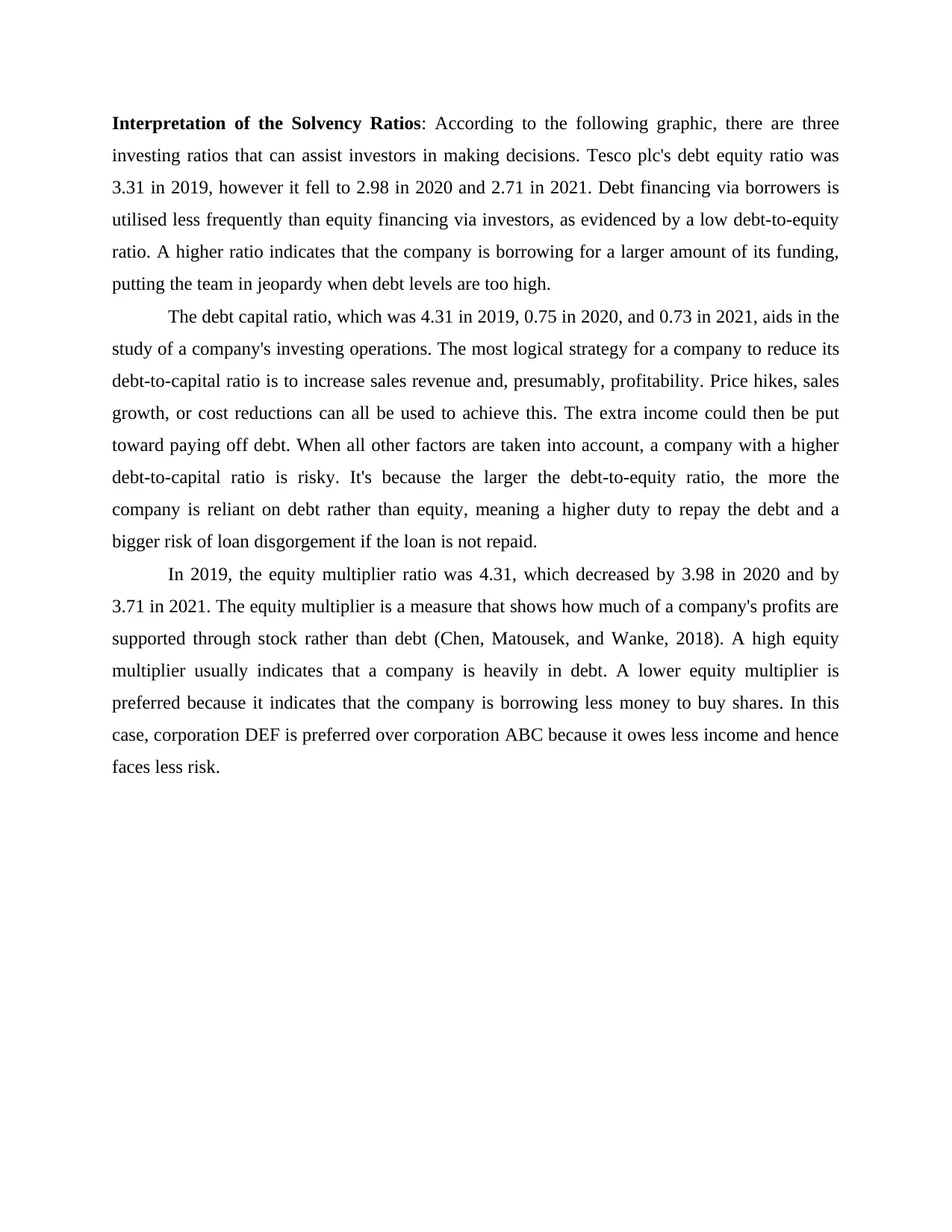
Interpretation of the Solvency Ratios: According to the following graphic, there are three
investing ratios that can assist investors in making decisions. Tesco plc's debt equity ratio was
3.31 in 2019, however it fell to 2.98 in 2020 and 2.71 in 2021. Debt financing via borrowers is
utilised less frequently than equity financing via investors, as evidenced by a low debt-to-equity
ratio. A higher ratio indicates that the company is borrowing for a larger amount of its funding,
putting the team in jeopardy when debt levels are too high.
The debt capital ratio, which was 4.31 in 2019, 0.75 in 2020, and 0.73 in 2021, aids in the
study of a company's investing operations. The most logical strategy for a company to reduce its
debt-to-capital ratio is to increase sales revenue and, presumably, profitability. Price hikes, sales
growth, or cost reductions can all be used to achieve this. The extra income could then be put
toward paying off debt. When all other factors are taken into account, a company with a higher
debt-to-capital ratio is risky. It's because the larger the debt-to-equity ratio, the more the
company is reliant on debt rather than equity, meaning a higher duty to repay the debt and a
bigger risk of loan disgorgement if the loan is not repaid.
In 2019, the equity multiplier ratio was 4.31, which decreased by 3.98 in 2020 and by
3.71 in 2021. The equity multiplier is a measure that shows how much of a company's profits are
supported through stock rather than debt (Chen, Matousek, and Wanke, 2018). A high equity
multiplier usually indicates that a company is heavily in debt. A lower equity multiplier is
preferred because it indicates that the company is borrowing less money to buy shares. In this
case, corporation DEF is preferred over corporation ABC because it owes less income and hence
faces less risk.
investing ratios that can assist investors in making decisions. Tesco plc's debt equity ratio was
3.31 in 2019, however it fell to 2.98 in 2020 and 2.71 in 2021. Debt financing via borrowers is
utilised less frequently than equity financing via investors, as evidenced by a low debt-to-equity
ratio. A higher ratio indicates that the company is borrowing for a larger amount of its funding,
putting the team in jeopardy when debt levels are too high.
The debt capital ratio, which was 4.31 in 2019, 0.75 in 2020, and 0.73 in 2021, aids in the
study of a company's investing operations. The most logical strategy for a company to reduce its
debt-to-capital ratio is to increase sales revenue and, presumably, profitability. Price hikes, sales
growth, or cost reductions can all be used to achieve this. The extra income could then be put
toward paying off debt. When all other factors are taken into account, a company with a higher
debt-to-capital ratio is risky. It's because the larger the debt-to-equity ratio, the more the
company is reliant on debt rather than equity, meaning a higher duty to repay the debt and a
bigger risk of loan disgorgement if the loan is not repaid.
In 2019, the equity multiplier ratio was 4.31, which decreased by 3.98 in 2020 and by
3.71 in 2021. The equity multiplier is a measure that shows how much of a company's profits are
supported through stock rather than debt (Chen, Matousek, and Wanke, 2018). A high equity
multiplier usually indicates that a company is heavily in debt. A lower equity multiplier is
preferred because it indicates that the company is borrowing less money to buy shares. In this
case, corporation DEF is preferred over corporation ABC because it owes less income and hence
faces less risk.
Paraphrase This Document
Need a fresh take? Get an instant paraphrase of this document with our AI Paraphraser
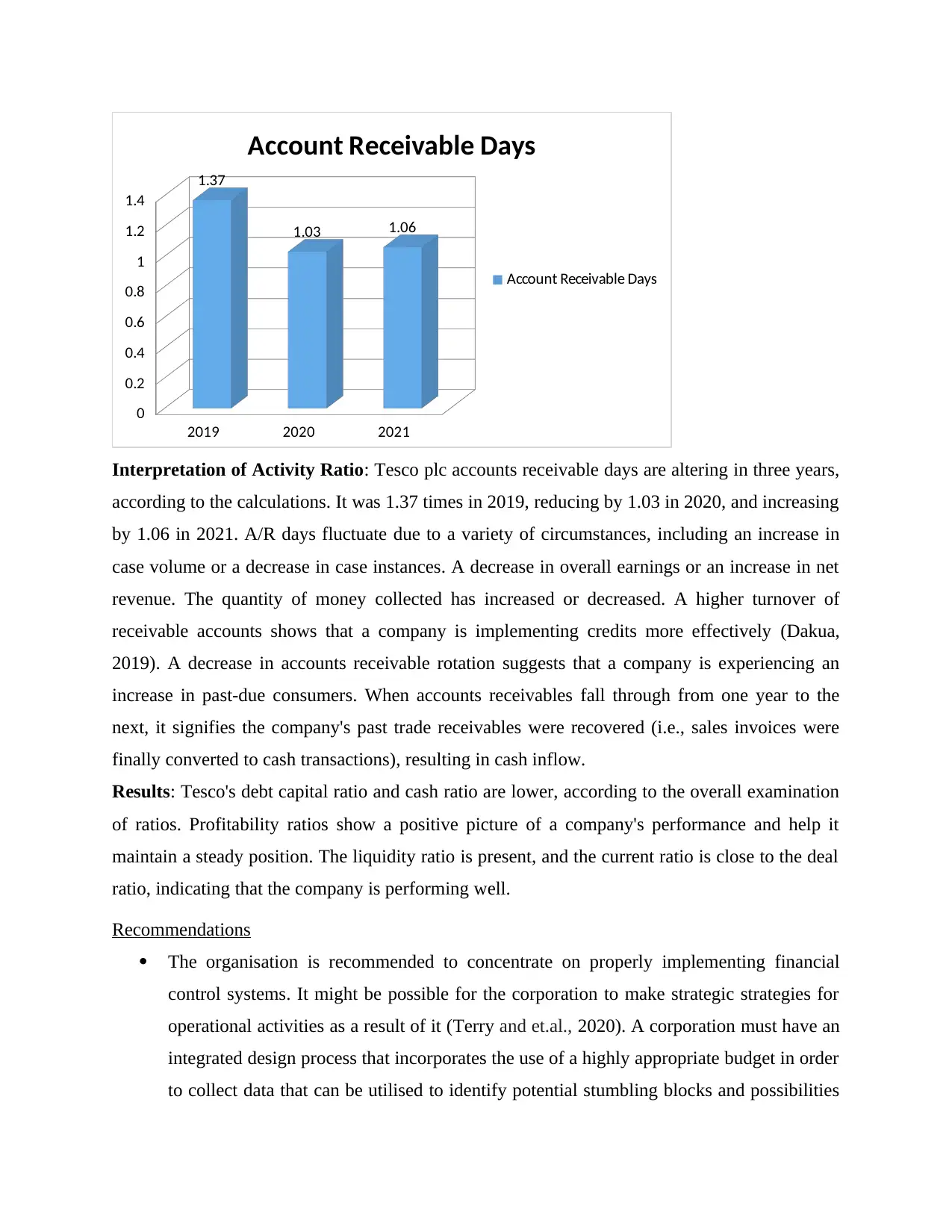
2019 2020 2021
0
0.2
0.4
0.6
0.8
1
1.2
1.4
1.37
1.03 1.06
Account Receivable Days
Account Receivable Days
Interpretation of Activity Ratio: Tesco plc accounts receivable days are altering in three years,
according to the calculations. It was 1.37 times in 2019, reducing by 1.03 in 2020, and increasing
by 1.06 in 2021. A/R days fluctuate due to a variety of circumstances, including an increase in
case volume or a decrease in case instances. A decrease in overall earnings or an increase in net
revenue. The quantity of money collected has increased or decreased. A higher turnover of
receivable accounts shows that a company is implementing credits more effectively (Dakua,
2019). A decrease in accounts receivable rotation suggests that a company is experiencing an
increase in past-due consumers. When accounts receivables fall through from one year to the
next, it signifies the company's past trade receivables were recovered (i.e., sales invoices were
finally converted to cash transactions), resulting in cash inflow.
Results: Tesco's debt capital ratio and cash ratio are lower, according to the overall examination
of ratios. Profitability ratios show a positive picture of a company's performance and help it
maintain a steady position. The liquidity ratio is present, and the current ratio is close to the deal
ratio, indicating that the company is performing well.
Recommendations
The organisation is recommended to concentrate on properly implementing financial
control systems. It might be possible for the corporation to make strategic strategies for
operational activities as a result of it (Terry and et.al., 2020). A corporation must have an
integrated design process that incorporates the use of a highly appropriate budget in order
to collect data that can be utilised to identify potential stumbling blocks and possibilities
0
0.2
0.4
0.6
0.8
1
1.2
1.4
1.37
1.03 1.06
Account Receivable Days
Account Receivable Days
Interpretation of Activity Ratio: Tesco plc accounts receivable days are altering in three years,
according to the calculations. It was 1.37 times in 2019, reducing by 1.03 in 2020, and increasing
by 1.06 in 2021. A/R days fluctuate due to a variety of circumstances, including an increase in
case volume or a decrease in case instances. A decrease in overall earnings or an increase in net
revenue. The quantity of money collected has increased or decreased. A higher turnover of
receivable accounts shows that a company is implementing credits more effectively (Dakua,
2019). A decrease in accounts receivable rotation suggests that a company is experiencing an
increase in past-due consumers. When accounts receivables fall through from one year to the
next, it signifies the company's past trade receivables were recovered (i.e., sales invoices were
finally converted to cash transactions), resulting in cash inflow.
Results: Tesco's debt capital ratio and cash ratio are lower, according to the overall examination
of ratios. Profitability ratios show a positive picture of a company's performance and help it
maintain a steady position. The liquidity ratio is present, and the current ratio is close to the deal
ratio, indicating that the company is performing well.
Recommendations
The organisation is recommended to concentrate on properly implementing financial
control systems. It might be possible for the corporation to make strategic strategies for
operational activities as a result of it (Terry and et.al., 2020). A corporation must have an
integrated design process that incorporates the use of a highly appropriate budget in order
to collect data that can be utilised to identify potential stumbling blocks and possibilities

in order to achieve business goals. It assists users in gaining knowledge that is useful in
making well-informed decisions that lead to outstanding results. It becomes conceivable
to better coordinate and conduct the company's operations.
The organisation should seek to cut costs that contribute to greater financial plan
depreciation and amortisation (Dakua, 2019). As a result, firms must seek out choices
that consume the least amount of money possible. They may target clients who are
willing to pay a greater commission for selling real estate.
To improve the business's liquidity position, the corporation may concentrate on
minimising current liabilities.
The company should try to reduce other non-operating expenses as it will increase the net
profit margin for the business and they can further focus on maximising the shareholder’s
wealth.
The business can focus on increasing their debt so that they have more capital and, in
turn, can take more risks and come up with more diversified products in the market.
CONCLUSION
Money should be managed properly in business, according to the aforementioned study report,
because any form of mismanagement in corporate finance might result in unfavourable business
scenarios. According to the preceding study, Tesco has a strong position in the retail sector and is
a smart investment.
making well-informed decisions that lead to outstanding results. It becomes conceivable
to better coordinate and conduct the company's operations.
The organisation should seek to cut costs that contribute to greater financial plan
depreciation and amortisation (Dakua, 2019). As a result, firms must seek out choices
that consume the least amount of money possible. They may target clients who are
willing to pay a greater commission for selling real estate.
To improve the business's liquidity position, the corporation may concentrate on
minimising current liabilities.
The company should try to reduce other non-operating expenses as it will increase the net
profit margin for the business and they can further focus on maximising the shareholder’s
wealth.
The business can focus on increasing their debt so that they have more capital and, in
turn, can take more risks and come up with more diversified products in the market.
CONCLUSION
Money should be managed properly in business, according to the aforementioned study report,
because any form of mismanagement in corporate finance might result in unfavourable business
scenarios. According to the preceding study, Tesco has a strong position in the retail sector and is
a smart investment.
⊘ This is a preview!⊘
Do you want full access?
Subscribe today to unlock all pages.

Trusted by 1+ million students worldwide
1 out of 18
Related Documents
Your All-in-One AI-Powered Toolkit for Academic Success.
+13062052269
info@desklib.com
Available 24*7 on WhatsApp / Email
![[object Object]](/_next/static/media/star-bottom.7253800d.svg)
Unlock your academic potential
Copyright © 2020–2025 A2Z Services. All Rights Reserved. Developed and managed by ZUCOL.





